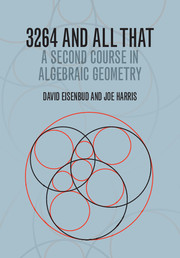Book contents
- Frontmatter
- Contents
- Preface
- Chapter 0 Introduction
- Chapter 1 Introducing the Chow ring
- Chapter 2 First examples
- Chapter 3 Introduction to Grassmannians and lines in ℙ3
- Chapter 4 Grassmannians in general
- Chapter 5 Chern classes
- Chapter 6 Lines on hypersurfaces
- Chapter 7 Singular elements of linear series
- Chapter 8 Compactifying parameter spaces
- Chapter 9 Projective bundles and their Chow rings
- Chapter 10 Segre classes and varieties of linear spaces
- Chapter 11 Contact problems
- Chapter 12 Porteous' formula
- Chapter 13 Excess intersections and the Chow ring of a blow-up
- Chapter 14 The Grothendieck Riemann–Roch theorem
- Appendix A The moving lemma
- Appendix B Direct images, cohomology and base change
- Appendix C Topology of algebraic varieties
- Appendix D Maps from curves to projective space
- References
- Index
Appendix C - Topology of algebraic varieties
Published online by Cambridge University Press: 05 March 2016
- Frontmatter
- Contents
- Preface
- Chapter 0 Introduction
- Chapter 1 Introducing the Chow ring
- Chapter 2 First examples
- Chapter 3 Introduction to Grassmannians and lines in ℙ3
- Chapter 4 Grassmannians in general
- Chapter 5 Chern classes
- Chapter 6 Lines on hypersurfaces
- Chapter 7 Singular elements of linear series
- Chapter 8 Compactifying parameter spaces
- Chapter 9 Projective bundles and their Chow rings
- Chapter 10 Segre classes and varieties of linear spaces
- Chapter 11 Contact problems
- Chapter 12 Porteous' formula
- Chapter 13 Excess intersections and the Chow ring of a blow-up
- Chapter 14 The Grothendieck Riemann–Roch theorem
- Appendix A The moving lemma
- Appendix B Direct images, cohomology and base change
- Appendix C Topology of algebraic varieties
- Appendix D Maps from curves to projective space
- References
- Index
Summary
Throughout this appendix we work with projective varieties X ⊂ ℙℂN —that is, with complex projective varieties. We can also view such a variety as a complex analytic, or holomorphic, subvariety of ℙℂN —that is, a subset locally defined by the vanishing of analytic equations—or, if X is smooth, as a complex submanifold of ℙNC. The topology induced from the standard topology on ℙℂN, referred to as the classical, or sometimes analytic, topology, is much finer than the Zariski topology with which we have dealt in this text. Using it, we can consider geometric invariants of X such as the singular homology and cohomology groups H*(X, ℤ) and H*(X,ℤ).
In this appendix, we explain a little of what is known about such invariants. Throughout, when we speak of topological properties of X, we refer to the classical, or analytic, topology.
GAGA theorems
One might think that there would be many more holomorphic subvarieties of ℙN than algebraic subvarieties, or that in passing from a smooth projective variety X over ℂ to its underlying complex manifold we would be losing information, since regular functions are holomorphic but not conversely. But this is not the case:
Theorem C.1 (Chow). Every holomorphic subvariety of ℙℂN is algebraic.
See for example Griffiths and Harris [1994, Section I.3] for a proof. Many further results in this direction were proven in Serre [1955/1956]. These are collectively known as the GAGA theorems, after the name of Serre's paper (“Géométrie algébrique et géométrie analytique”).
It follows immediately from Chow's theorem that if X and Y are projective varieties over C then any holomorphic map f : X → Y is algebraic (Proof: Apply Theorem C.1 to the graph Γf ⊂ X × Y). Not quite so immediate are the facts that any holomorphic vector bundle on a projective variety is algebraic and that if ε is any such vector bundle on X then any global holomorphic section of ε is algebraic. More generally, the Čech cohomology groups of ε will be the same, whether computed for the sheaf of holomorphic sections of ε in the analytic topology or the sheaf of regular sections in the Zariski topology.
- Type
- Chapter
- Information
- 3264 and All ThatA Second Course in Algebraic Geometry, pp. 543 - 563Publisher: Cambridge University PressPrint publication year: 2016

